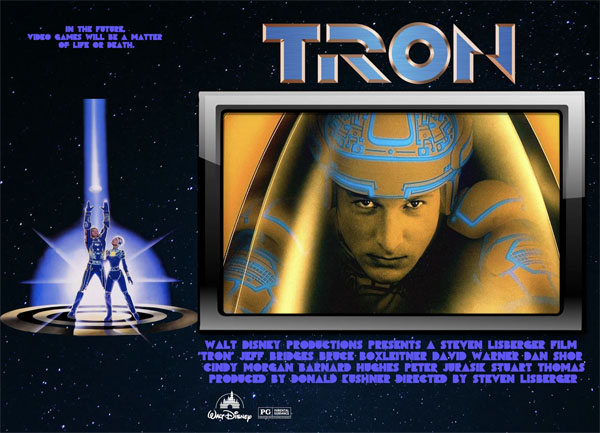
Well over a decade before Woody the Cowboy, Buzz Lightyear, and the cast of Toy Story were a glint in the pixel of a computer’s eye, a young animator named John Lasseter sat in wide-eyed wonder in a movie theater.
It was 1982, and Lasseter watched a scene from a new movie called Tron. “It blew me away!” remembered Lasseter in a 1999 interview. “A little door in my mind opened up. I looked at it and said, ‘This is it! This is the future!'”
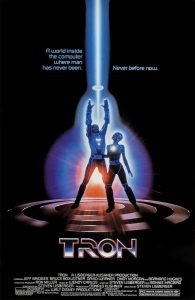 Many in and outside of the film industry felt the same way. Approaching its 41st anniversary this summer, Tron signaled the start of a new age, the computer age, of filmmaking. Today, computer-generated imagery (CGI) is commonplace and a part of almost every film production.
Many in and outside of the film industry felt the same way. Approaching its 41st anniversary this summer, Tron signaled the start of a new age, the computer age, of filmmaking. Today, computer-generated imagery (CGI) is commonplace and a part of almost every film production.
Tron was the flashpoint for all we see today.
Directed by Steve Lisberger, Tron combined live-action and animation as it told the story of a computer hacker and video game arcade owner named Kevin Flynn (played by Jeff Bridges), who finds himself struck by a digital laser and transported inside a computer.
Here, he is in a digital world ruled by the Master Control Program (MCP) and his evil henchman, Sark (David Warner). With the help of a security program named Tron (Bruce Boxleitner) and Yori (Cindy Morgan), an input/output program, Flynn must destroy the MCP and free the system from its control.
In a nice, Wizard of Oz-like touch, the computer programs resemble the humans (and portrayed by the same actors) in the real world who created them.
Tron was the brainchild of Lisberger, an animator (he conceived and produced Animalympics for NBC), who was fascinated with video games. He and his producing partner, Donald Kushner, spent two years researching the technology used in the film.
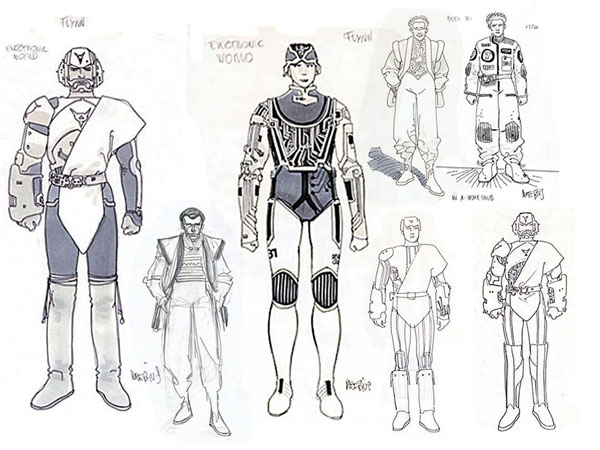
Early character designs for TRON by Moebius (Jean Giraud).
Computer graphics had been used in films before Tron (such as Westworld and Star Wars), but not to the extent they were utilized here. As this was the very early days of CGI, this came with its time-consuming challenges. Lisberger told writer Susan King of Variety in 2017: “There was no movement. Computers could only generate individual frames. There was no way to digitally put them on film, so you actually set up a motion picture camera in front of the computer screen, and you filmed it frame by frame. Some of the frames took hours to generate.”
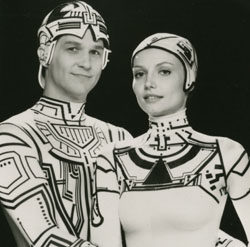
Jeff Bridges (Flynn) and Cindy Morgan (Lora) in TRON.
Of course, with four decades of advancements, many may feel that Tron has an aged feel to it. However, watching the now-iconic light cycle race, or scenes with the Solar Sailer, one feels the same sense of jaw-dropping wonder that Mr. Lasseter felt in 1982.
There’s a genuine appreciation for Tron. The smooth, flowing movements seen here had seemed out of reach until this film.
Unfortunately, this appreciation didn’t reach audiences or critics at the time. While some, like Roger Ebert, awarded the film the highest honor of four stars, others were not so kind. Variety felt that the film “…falls way short of the mark in story and viewer involvement.”
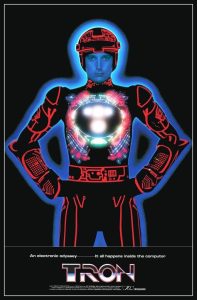 It was a modest box-office success (E.T. The Extra-Terrestrial was the behemoth summer movie that year and ruled at theaters). While the merchandise associated with the film did well, Tron was seen as a financial disappointment.
It was a modest box-office success (E.T. The Extra-Terrestrial was the behemoth summer movie that year and ruled at theaters). While the merchandise associated with the film did well, Tron was seen as a financial disappointment.
However, the impact and influence of the film on the industry would be felt for years after, as it served as the gateway for so many into the possibilities of computer animation. Additionally, a cult following from fans swelled through the years into mainstream popularity for the film.
By 2010, the Disney Studio embraced this delayed admiration. It produced the long-awaited sequel, Tron: Legacy, which brought back Jeff Bridges, Bruce Boxleitner, and the world of the original, now brought back to life in our anything-is-possible era of CGI.
In the 2017 Variety article, director Lisberger reflected on Tron. Forty years later, his words still stand as testament to the film’s legacy: “Tron, said Lisberger, is ‘so idealistic. It was the digital frontier, and we were seeing it and exploring it for the first time. We were very, very idealistic, and you can feel that when you watch Tron.”


 Michael Lyons is a freelance writer, specializing in film, television, and pop culture. He is the author of the book, Drawn to Greatness: Disney’s Animation Renaissance, which chronicles the amazing growth at the Disney animation studio in the 1990s. In addition to Animation Scoop and Cartoon Research, he has contributed to Remind Magazine, Cinefantastique, Animation World Network and Disney Magazine. He also writes a blog, Screen Saver: A Retro Review of TV Shows and Movies of Yesteryear and his interviews with a number of animation legends have been featured in several volumes of the books, Walt’s People. You can visit Michael’s web site Words From Lyons at:
Michael Lyons is a freelance writer, specializing in film, television, and pop culture. He is the author of the book, Drawn to Greatness: Disney’s Animation Renaissance, which chronicles the amazing growth at the Disney animation studio in the 1990s. In addition to Animation Scoop and Cartoon Research, he has contributed to Remind Magazine, Cinefantastique, Animation World Network and Disney Magazine. He also writes a blog, Screen Saver: A Retro Review of TV Shows and Movies of Yesteryear and his interviews with a number of animation legends have been featured in several volumes of the books, Walt’s People. You can visit Michael’s web site Words From Lyons at: 






















The sequel didn’t work for me precisely BECAUSE the technology had come so far. The original’s computer graphics and hand-painted live actors still work, taking us somewhere that still registers as a unique but plausible world.
TRON’s universe was beyond what contemporary real-world CGI could do, but was believable in context. The design work throughout sells the idea of this being the flip side of the computer user’s / gamer’s experience. The sequel was visually impressive but ultimately generic sci-fi.
A crude analogy might be the old “Rocky and Bullwinkle” show. The visuals often looked cheap and improvised, a perfect match for the fast, irreverent humor. Later, shows like “Freakazoid” tried for the same anarchic feel. Higher-quality animation and lush scoring actually worked against it.
I disagree about “Freakazoid!”as I thought the humor was good not matter the production value was. Heck, I’m still disappointed it didn’t get a third season.
I am sorry, but that is complete nonsense.
“Generic”?!
Tron Legacy is the most perfect sequel ever made, and quite probably the most perfect movie ever made.
The original Tron sparked our imagination for computers and tech. What did all this new 1980s technology mean? Video games, corporations, globalization, lasers, the grid, A.I. and A.I. dangers… Biodigital jazz, man. It was as relevant then as it is today.
How could the sequel possibly capture all those key elements? Address the philosophical questions, keep the style and minimalist dialog, show all the iconic devices from the original? Picture clusters of information as they traveled through the computer… Ships, motorcycles?
Not only did they deliver, from the Big Door onwards, but they found a way to incorporate a rich new level of detail and storyline. ISOs! Time dilation! CLU: a perfect callback to the original opening scene with a Jeff Bridges computer clone! And they remembered the Solar Sailer!
Put Daft Punk on top of that and I’m sorry, but I just literally died.
The real story is why the media is covering up the Tron 3 travesty. Legacy’s cast was immaculate. And now… Jared Are You Kidding Me LETO?!
Does Disney not know he led an actual Jared Leto cult? That he was in the worst Marvel movie, and also the worst DC Movie, and that he is the primary reason those movies suck because he’s a terrible actor? That other actors don’t want to work with him because of his on-set behavior?
Where’s the coverage of that???
Rather disappointed a third film was sheleved partly due to the success of the Marvel film and the company buying Lucasfilms. I still want them to try it instead of remaking their animated films which I’m sure Walt Disney Animation isn’t completely happy about.
As far as video games based on a film about video games goes, the series managed to deliver with two quality arcade titles and several home releases for the Intellivision and Atari 2600 consoles.
The disc-battle scene in particular wound up being adapted into several games, the most notable of which was “Discs of TRON” for the arcades – the cabinet alone is worth the admission thanks to its colossal size!
Wow – I didn’t know the guy responsible for TRON also worked in ANIMALYMPICS! I gotta admit I liked ANIMALYMPICS better.